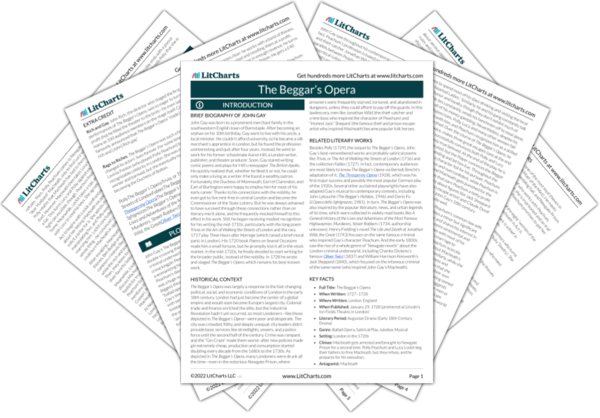Peachum’s account book represents the way modern economies corrupt people by making them care more about money than morality or other people. Peachum carries his account book with him everywhere and meticulously records every purchase, sale, and bounty in it. He is obsessed with profit, which he demonstrates to the play’s audience by constantly going over his accounts. In fact, the audience even learns about Peachum’s nefarious occupation by watching him flip through his account book in the opening scene. He reads off each thief’s name and decides who gets to live and die, based on how much profit they bring in. Notably, the audience never even sees the people who die—instead, they see what each execution means to Peachum: another £40 on another line in his book. Between stolen goods and executions, Peachum’s accounts are a tabulation of other people’s suffering, and his life goal is to make the numbers go as high as possible.
Of course, John Gay also uses Peachum’s profit obsession to criticize English society as a whole. While 18th century England was not yet capitalist in the modern sense—the Industrial Revolution hadn’t even happened yet—it was already growing rich, mainly by plundering its overseas colonies. (This is how wealthy Londoners got all the gold, jewels, and fine silk that Peachum and Macheath steal.) In turn, Gay suggests, this newfound wealth was changing English society by encouraging everyone to become thieves and scoundrels. Put differently, once people get a taste of wealth, they often become willing to harm and exploit other people in order to get more of it. And once whole societies start to base themselves on the logic of the market, it’s not long before exploitation, violence, and immorality become the cost of doing business.
Account Book Quotes in The Beggar’s Opera
Robin of Bagshot, alias Gorgon, alias Bluff Bob, alias Carbuncle, alias Bob Booty.










